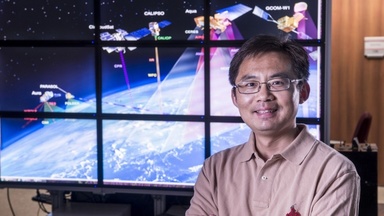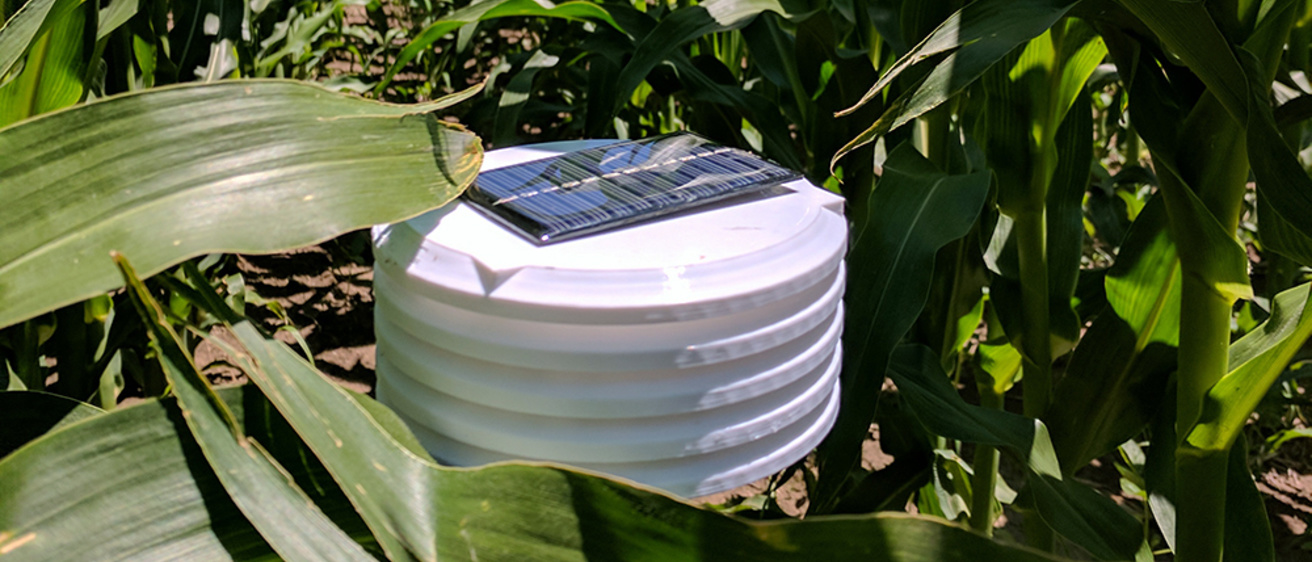Imagine if an Iowa farmer could more accurately predict the weather, monitor water quality, and keep tabs on soil conditions.
They could better decide when to plant, spray, and harvest, manage the land, and ultimately produce healthier, more abundant crops with less environmental impact.

“NASA satellite data provide a lot of very useful information for agriculture each day, in real time,” said Jun Wang, assistant director of the University of Iowa Technology Institute (ITI). “But the Iowa workforce is not trained to use these data.”
Connecting valuable NASA data and the Iowans who could benefit from them most is at the heart of a new multidisciplinary, multi-university grant from the Iowa Space Grant Consortium called the Infrastructure for Data-Advanced Research and Education (I-DARE).
The four-year program awarded in June 2020 aims to cultivate a science, technology, engineering, and math (STEM) workforce in farming-related businesses and operations from the field to precision agriculture. The workforce would be armed with skills to harness NASA’s Earth science and technology data to respond to Iowa-centric problems related to weather, agriculture, and natural resources, such as severe weather, soil moisture, and temperature fluctuations.
Wang, the James E. Ashton Professor in the College of Engineering, is principal investigator among a team from UI, Iowa State University, and the University of Northern Iowa.
"The data are intended for us to engage with farmers and allow farmers to understand and access the data easily," Wang said. "Our next-generation farmers need to be equipped with a set of tools and knowledge to manage the weather intelligence and the ever-changing natural resource data that is key for farming operations."
"The severe weather events, such as the recent derecho event, drought, flood, heat waves, or even the outlook of the next week's weather can affect the harvesting operations," he said. "Wind can affect aviation pesticide operation. Soil moisture can affect the fertilization operation. Temperature affects the seed planting operation."
The I-DARE grant includes three main components:
- A 12-day STEM research-oriented summer camp beginning in June 2021 with six-day camps each of the following three years. The camp format is subject to change, if needed, in response to the pandemic.
- Integration of NASA’s science and research into courses at the home universities of investigators and collaborators.
- Online training through the I-DARE virtual facility and the citizen science network, in which citizens measure weather parameters using small, low-cost sensors.
The summer camp will enroll up to 15 undergraduate and graduate students from colleges and universities around Iowa. While details are still being worked out for the first camp next summer, interested students can apply online here: https://esmc.uiowa.edu/idare_campaign.php. If selected, students will be provided full financial support and a stipend to attend the summer camp.
Grant investigators and collaborators with expertise in satellite remote sensing, Earth system modeling, flight planning, field experiments, big data analytics, and machine learning will teach classes to camp participants.


supports the Hawkeye
Hyperspectral Sensor
Camp participants will gain hands-on experience developing field experiments to collect data from the Earth’s surface and the air. In addition, they will help collect detailed, high-resolution images from the aircraft-based Hawkeye Hyperspectral Sensor and then analyze the data to determine soil and plant conditions, water vapor absorbing into the atmosphere, water quality, flood detection, and other metrics.
The new data will be combined with NASA’s satellite data and eventually be used in the classroom to allow students to learn with current information, replacing outdated information in textbooks.
The program will leverage several resources including ITI’s Operator Performance Laboratory (OPL) flight facility, which will be home base for much of the camp, and algorithms and “smart” weather sensors from ITI’s Atmospheric and Environmental Research (AER) Lab.

Brian Hornbuckle, a professor of agronomy at Iowa State University, said Iowa needs to better understand the accuracy of existing sensors, computer models, satellites, and other tools used to generate weather estimates, and how far into the future the tools can accurately forecast the weather.
“My guess is we will find estimates and accuracy are not adequate,” Hornbuckle said. “We need to quantify what we are doing now and what we need to do to make it better.”
Students in the camp will learn critical thinking about satellite remote sensing and uncertainties in satellite data.
“I hope the summer camp will help to get young scientists excited about this area, and they start to develop a vision for how to provide information to the public and improve the prediction system, so people can make better decisions about the environment,” Hornbuckle said.
Applications for the data include weather forecasting, flood and water-quality monitoring, agricultural innovation, and studies of climate change and natural resources (wind and solar energy).

Marc Linderman, an associate professor of geographical and sustainability sciences in the UI College of Liberal Arts and Sciences, will work with students collecting data from the air with the Hawkeye Hyperspectral Sensor.
“Bringing in people from different institutions and areas of expertise improves our understanding and allows us to better and more accurately model what we are looking at,” Linderman said.
Other investigators and collaborators include Tom Schnell, director of OPL and a UI professor of industrial and systems engineering; Corey Markfort, a UI civil and environmental engineering assistant professor; Fatima Toor, a UI associate professor of electrical and computer engineering; Jing Zeng, a UI lecturer in chemical and biochemical engineering; and Xinhua Shen, an assistant professor of meteorology and air quality at UNI.
The I-DARE grant, with NASA’s and the university’s in-kind support, is valued at $457,915 and runs through June 2024.
More information about the I-DARE project can be found at https://esmc.uiowa.edu/idare_description.php.
